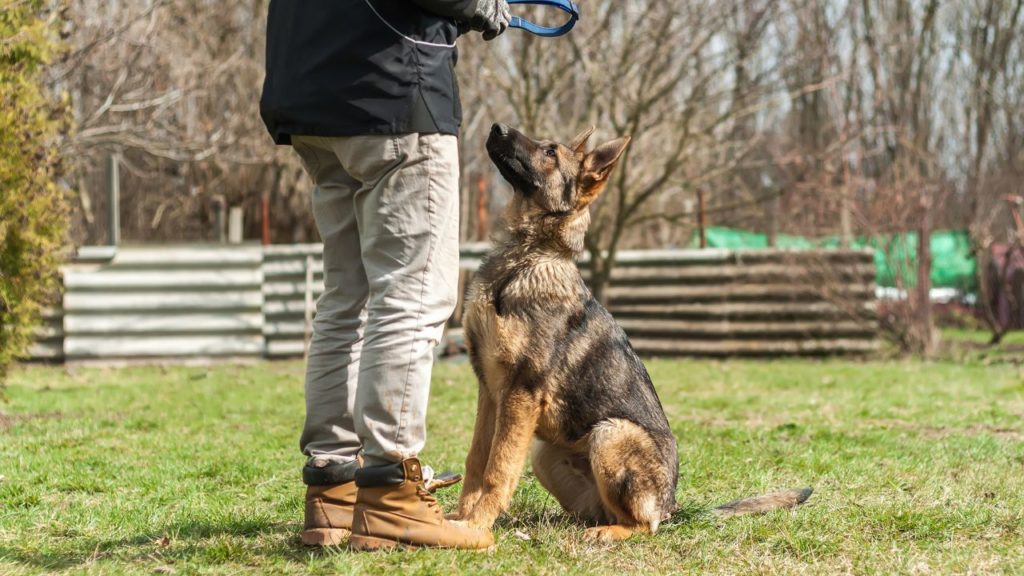
Shock collar training is a controversial topic. It’s important to understand the basics of when and how this type of training should be used. This post will cover when to start shock collar training? What shock collars are when it’s appropriate to use them, and how do they work.
Shock collar training can be an effective way to keep your pet safe while they are outside.
By understanding the principles behind this form of remote control punishment, you’ll have more peace of mind knowing that your furry friend won’t get too far away from home while exploring on his own.
When Can You Start Using A Shock Collar On A Puppy?
Shock collar training can be a useful tool once your dog has passed a few milestones in its life. Generally, the absolute earliest that this type of remote control training should start is when your puppy is completely crate trained.
It’s important to have a good understanding of how to use the shock collar before you begin applying it to your pet’s neck.
We recommend using it when your puppy reaches the age of 10 weeks, but we see much better results in puppies aging 6 months and older; here, we also recommend that shock collar training must come after crate training, potty training, and house training.
Shock Collar Training and Canine Age In
In comparison to dogs, puppies go through a lot of similar developmental stages. Therefore, it is important to know the key milestones for your dog’s breed or age to start with shock collar training on the right foot.
This remote control training should only be used when your pet has reached certain mental and physical readiness points.
To begin, your pup should be completely over the fear of loud noises. This is when puppy socialization training can begin in earnest.
Puppies should also meet their first vaccination schedule, which consists of shots around 6 to 8 weeks.
Things To Know Before Buying A Shock Collar For Your Puppy
When you purchase a shock collar, make sure that you’ve done your research first. There are many humane options available; however, the type of remote control punishment device that is most effective will depend on your dog’s breed and age
The right style of training device should only be used at the lowest intensity. This is so that you can gradually raise the levels as your pet becomes more accustomed to getting “zapped” every time they misbehave.
You should always purchase a training device from a respected brand and make sure to read reviews of other people who have used it on their dogs before making a decision.
Some shock collars are great for training, while others are cheaply made and have poor, remote control range.
How To Train Your Puppy To Come With A Shock Collar
Video
Dogs in the early ages are much easier to train, especially the sit command “come.” The above video will help you to teach your dog how to obey this command.
How To Train Your Puppy To Stay In The Yard With A Shock Collar
Training your puppy to stay in the yard should be the first thing you teach him when he loves to visit outside.
This way, your dog will always come back home and never wander into other people’s yards or roam around.
video
How To Train Your Puppy To Sit With A Shock Collar
Here is the video tutorial to practice the training with your dog.
How To Train Your Puppy To Stay With A Shock Collar
Well, when dogs are charged, it’s hard to hold them; no command work at that time, and owners remain helpless.
But a well-behaved dog or a fully trained dog always obeys commands and stays is one of them. So this command is used to keep the dog limited / Stopped where they are.
Grasping Shock Collar Training
Training your dog will not be that tough if you teach them at the starting age.
It becomes harder to train your adult dog because they don’t like to get trained by devices.
video
The Perks of Shock Collar Training for Dogs
Dog Training Collar is not harmful to your dog. There is no proven scientific evidence of harm to the canine if trained with a shock collar.
It is advisable not to go beyond the level you have set for your dog. However, there have been cases that “some dogs might have an unknown injury or possibly a pre-existing medical condition which was not discovered before the use of a shock collar,” which could have been the cause.
Shock Collar Training Can Minimize Aggression in Dogs
With the use of shock collars, barking can be minimized during training sessions. However, some dogs are too stubborn to listen and bark excessively when ordered to stop or do something else.
If shock collars are used to train these dogs, they can be turned into the correct action that the owner wants.
Shock collars are safest when owners use them with their dog’s natural learning process, like how a mother would with her own puppies. As a general rule of thumb, owners should not use shock training on puppies less than 6 months of age.
Shock collars are commonly used for barking problems in dogs, but other types of training can be done with them.
These dog shock collars can be utilized for training purposes to make a pet learn the right behavior and avoid unwanted habits such as digging or chewing furniture. For example, if dogs start digging in the garden or lawn, owners can take advantage of this training collar to make them stop.
Shock collars are also used for obedience training and making dogs learn faster. Once they get accustomed to wearing these devices, they’ll work better with the owner’s commands.
It is not advisable to use shock collars on dogs that are stubborn or have dominance issues. These dogs might not respond well to the training method and could even turn aggressive on their owners instead.
Shock Collar Purchase Tips
Before buying a shock collar, consider the following tips:
- 1. Keep in mind that there are different training modes with dog shock collars; one is to control barking while the other is to reinforce lessons and commands taught by owners. It’s best to get two separate units if dogs learn better via voice commands rather than stimulation.
- 2. When shopping for shock collars, choose the standard models instead of those with remote controls. These are costlier and tend to be more complicated, which can make training time longer.
- 3. Expect to shell out some money if buying these modern dog shock collars, especially those that offer advanced features like an extra collar receiver or remote control.
- 4. Check reviews so you’ll have an idea of what other users are saying about their experience with this product.
- 5. Do some research on the brand that offers these shock collars to check its background, reputation, and longevity in the business. This way, buyers can select trusted dog shock collar manufacturers for faster support after purchase.
- 6. To prevent dogs from habitually barking, it is advisable to buy cheaper shock collars that only produce static stimuli. These are gentler than the ones with electrical shocks and can be used for extended periods of time.
Request Recommendations From Credible Sources
There are several sources of information on the Internet about dog shock collars. However, it is best to consult with experts, like veterinarians and animal behaviorists, to get their recommendations on the right type for each specific pet.
It’s also essential to talk with your vet before getting these devices. After all, they have insight into what is best for your pet and can make sound suggestions.
Take the Time to Learn About Correct Use
The more information about dog shock collars, the easier it will be to make the right purchase decision. Unfortunately, some pet owners opt for cheap models without instructional material that can lead to misuse and incorrect use.
Owners should only get quality devices while learning how to maximize their potential at the same time. They can find additional support with the instructional DVD that most brands include in the package.
Before making any purchase, it is advisable to ask for recommendations from friends or family members who have experience with these training tools. They can share their experiences so people will know what to expect if they buy one for their pets.
It’s also wise to consult with veterinarians before getting shock collars for dogs. They have valuable insight into this product and can make recommendations on the right type to buy and how to use it best.
Owners should also learn more about dog shock collars so they won’t waste their money on those without instructional materials or those with low quality.
